Femtosecond laser creates ‘programmable’ optical qubits in silicon
Laser Focus World: What inspired your work with quantum qubits/networking?
Kaushalya Jhuria: Our inspiration comes from the transformative potential of quantum computers. They can solve intricate problems in areas like human health, drug discovery, and artificial intelligence at speeds far exceeding those of current supercomputers.
The idea of creating a secure and highly efficient quantum internet that can outperform current optical-fiber technologies also drives our work.
LFW: Can you describe the basic concepts involved and how it works?
Jhuria: We use a femtosecond laser, which emits extremely short pulses of energy that last only a quadrillionth of a second. This laser allows us to precisely target specific areas in silicon that are doped with hydrogen and carbon to create qubits (see video). These qubits, known as quantum emitters, color centers, or spin-photon qubits, can transmit information over long distances, which is ideal for building a scalable and secure quantum network.
LFW: Any cool design work involved? What does your laser setup look like?
Jhuria: Our laser setup features an ultrafast femtosecond laser system that delivers precisely controlled energy pulses to microscopic targets in silicon. The setup includes mechanisms for adjusting the laser’s intensity and positioning to ensure precise qubit formation. We also use a near-infrared detector—with single-photon level sensitivity for high-precision measurements—to analyze the photoluminescence signals from the qubits, which helps us understand and optimize their properties.
LFW: Main thing you’d like people to know about your work?
Jhuria: The key takeaway is that our method enables the programmable and precise creation and annihilation of qubits in silicon, which is essential for developing scalable quantum computers and networks. This technique builds on existing silicon-based technology, making it feasible for large-scale production.
Its main benefit is the potential to create reliable and interconnected quantum systems capable of handling complex computations that classical computers cannot.
LFW: Most surprising/coolest aspects of your work? Any ‘a-ha’ moments and what did it feel like?
Jhuria: One of the most exciting moments was rediscovering the so-called Ci center, a type of quantum emitter with promising properties for spin-photon qubits. We knew about the Ci center from earlier literature, but successfully creating it with our method was unexpected. Common quantum emitters in silicon, such as the G center, readily form when using the widely adapted approach of ion implantation followed by rapid thermal annealing under inert gas ambiance.
In our approach, we first replaced the annealing ambiance from an inert gas with forming gas to introduce additional hydrogen in the silicon lattice. By doing this, the commonly present and dominating G centers get passivated while the more promising Ci centers form. Here, the addition of hydrogen boosted the brightness of Ci centers by several orders of magnitude—an unexpected effect we discovered in experiments and theoretical analysis of the center’s structure. This breakthrough was a significant ‘a-ha’ moment, which validates our approach and opens new possibilities to program the formation of color centers with properties tailored for specific applications.
Another ‘a-ha’ moment was when we could precisely program the writing and erasing of these qubits with femtosecond laser pulses at a single quantum emitter level.
It was also incredibly rewarding to see our theoretical work come to life in the lab.
LFW: Challenges to overcome?
Jhuria: Our main challenges include improving the precision and efficiency of qubit formation and ensuring their stability through thermal cycles and at room temperature. Additional challenges involve integrating these qubits into complex quantum devices and achieving reliable interactions between different qubits, which is essential for quantum entanglement.
LFW: Applications?
Jhuria: Our work has numerous potential applications. Building quantum computers with thousands of connected qubits is a grand challenge, and scaling quantum information processing power will require efficient quantum interconnects.
Our technique can be used to address these opportunities and lead to advances in quantum networking and the development of a quantum internet. This would have major implications for secure communications, data encryption, and processing large datasets at unprecedented speeds. Industries like finance, healthcare, and artificial intelligence could greatly benefit from these advancements.
LFW: What’s next?
Jhuria: Our next steps involve integrating these optical qubits into practical quantum devices, such as optical cavities and waveguides, to study their interactions and optimize their performance for various applications. We also aim to discover other new spin-photon qubit candidates with properties tailored to specific quantum computing and networking tasks.
Ultimately, we’re working toward developing a fully functional and scalable quantum network that connects local quantum information processing nodes.
FURTHER READING
“New Technique Could Help Build Quantum Computers of the Future,” Lawrence Berkeley National Laboratory news release (Jun. 11, 2024).
About the Author
Sally Cole Johnson
Editor in Chief
Sally Cole Johnson, Laser Focus World’s editor in chief, is a science and technology journalist who specializes in physics and semiconductors.


